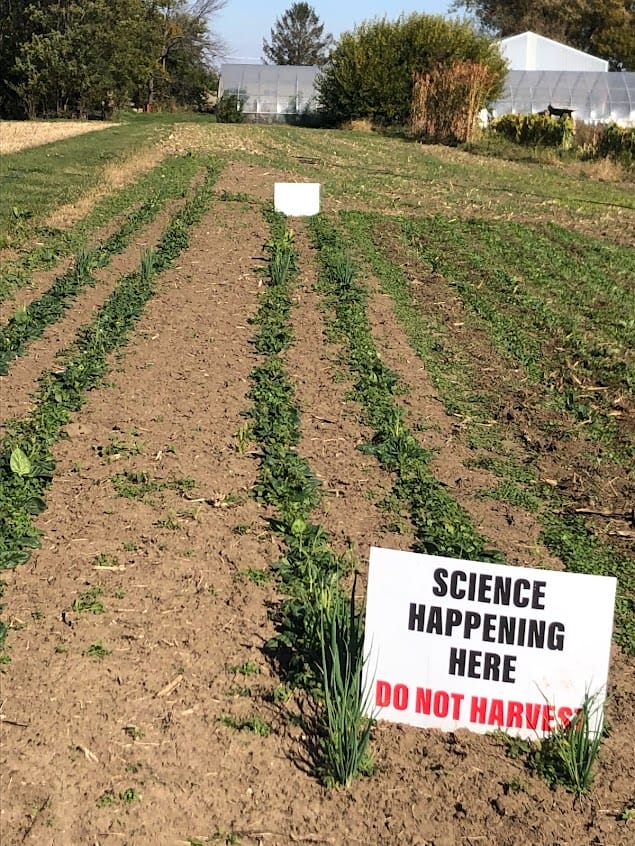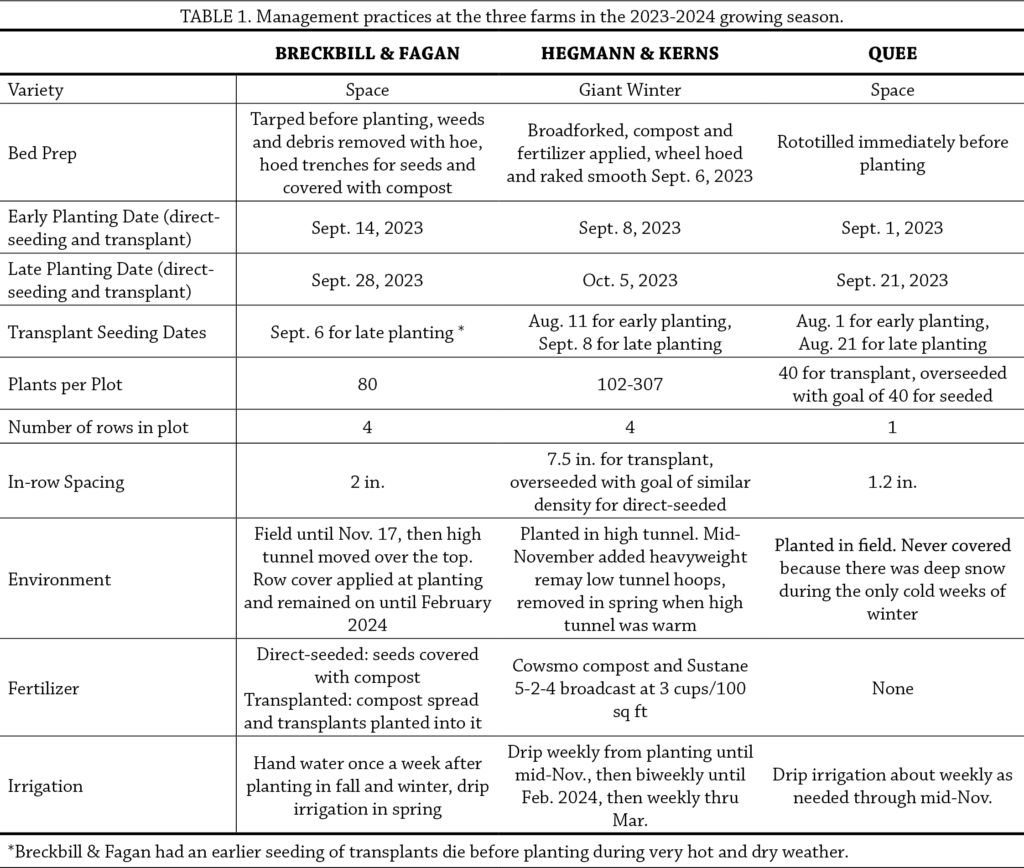Planting Date and Method for Overwintering Spinach
This research report was funded by Iowa Department of Agriculture and Land Stewardship.
In a Nutshell:
- Overwintering spinach is the practice of insulating a fall-planted spinach crop through the winter. This practice produces an early spring crop of sweet, delicious spinach.
- A group of PFI farmer-researchers wanted to continue investigating the best time to plant spinach for overwintering and test whether direct-seeding vs. transplanting performed better.
Key Findings
- At two of three trial locations, early-September plantings outyielded late-September plantings of spinach. At a third location, yield was not affected by planting date, but number of harvestable plants was greatest in a late-September direct-seeded treatment.
- A very warm late summer affected the ability of some farmers to start and establish transplants in September, and a warm winter led to reduced need for insulation and early spinach harvests.
Background
Overwintering spinach is a common practice where farmers plant spinach in the late summer, insulate the plants through the winter and harvest beginning in the early spring. This practice produces a very early season spinach crop that is uniquely sweet because the overwintered plants concentrate sugar in their leaves to prevent freezing. However, farmers routinely have questions about when and how to plant and manage spinach for overwintering, especially in increasingly volatile shoulder-season weather. PFI cooperators have previously conducted trials exploring how planting timing affects yields and harvest windows of overwintered spinach as well as other overwintered greens [1, 2, 3]. This research found that seeding spinach in early-to-mid September resulted in a longer harvest window and sometimes a larger overall yield compared to seeding in mid-October.
In 2023, Hannah Breckbill & Emily Fagan, Natasha Hegmann & Peter Kerns and Mark Quee decided to explore whether planting fall spinach even earlier than mid-September could further increase yields. Because seeding methods sometimes vary by farm, they also chose to investigate whether direct-seeding vs. transplanting the spinach impacts total yields and harvest windows. Breckbill & Fagan note that they decided to conduct another trial because “it will keep us organized about our learning and help us come to a more definitive conclusion about how to plan our crops and have yields that we can count on.” Hegmann & Kerns report that they are hoping to capitalize on successful winter greens production and scale up to wholesale production in the coming years. “I’ve done quite a bit of messing around with tunnel greens, season extension and overwintering, but I hope that this research will bring some focus and help us dial in fall spinach production. At the end of the trial, I hope that I am a more confident spinach producer! No more questions about when I should seed or if I should seed or transplant spinach, just a plan that we can execute each year!”
Methods
Design
All three farms tested a total of four treatments: Early direct-seeding, Early transplant, Late direct-seeding and Late transplant. Direct-seeding and transplanting occurred at the same time at each of the Early and Late dates. Planting dates and overwintering protection strategies varied due to local weather and individual preferences and are listed in Table 1 along with management details. Figure A1 shows an example of the statistically robust experimental design used by cooperators. Cooperators randomly assigned four replications of each treatment across their beds for a total of 16 plots.
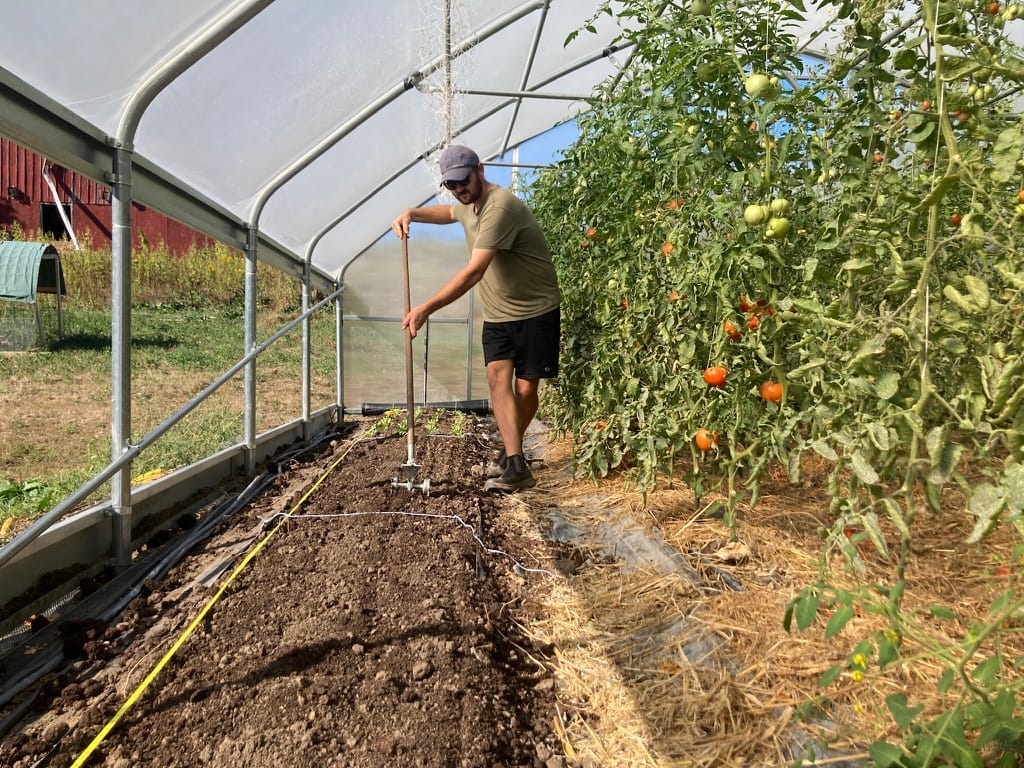
Pete Kerns preparing spinach beds for direct-seeding and transplant. Transplanted spinach is visible behind Pete. Photo taken Sept. 8, 2023.
Measurements
Cooperators tracked labor hours spent seeding and caring for and harvesting spinach throughout the trial. At each harvest date, they weighed spinach harvests from each plot and assessed spinach quality. Quee also counted the number of individual harvestable plants.
Data analysis
We used analysis of variance (ANOVA) followed by a Tukey’s HSD at a 95% confidence level to determine if there were significant differences between total seasonal yield of the four treatments. For each metric, the difference between any two treatments is compared with the HSD. A difference greater than or equal to the HSD indicates the presence of a statistically significant treatment effect, meaning one treatment outperformed the other and the farmer can expect the same results to occur 95 out of 100 times under the same conditions. A difference smaller than the HSD indicates the difference is not statistically significant and the treatment had no effect. We can perform this analysis because the cooperators had completely randomized and replicated experimental designs (Figure A1).
Results and Discussion
Management time
Regardless of planting date, transplanting spinach took more time than direct-seeding spinach at all three trial locations (Table 2). This was due to the extra time needed to plant the seeds into trays and plant the transplants after the beds are prepared. There were no statistically significant differences in the amount of time required to harvest one pound of spinach from the direct-seeded or transplanted treatments. There were also no statistically significant differences in harvest time per pound of spinach between Early- and Late-planted spinach in either method. Quee reflected that “I’m glad I did both transplanting and direct-seeded. I’ll definitely direct sow overwintered spinach, but I still need to work out some of the details. I also learned a lot about fall soil disturbance and spring henbit (weed pressure). I really need to figure out a way to overwinter the spinach without creating perfect conditions for henbit. This was not an expected observation…”
Yield and harvest windows
Statistical analysis revealed that seeding method (direct-seeding vs. transplanting) did not significantly affect yields in any of the three trials. Hegmann & Kerns found planting by either method on Oct. 5 resulted in 80-95% lower per plot yields than planting earlier, on Sept. 7 (Figure 1). Similarly, Breckbill & Fagan found that their Early direct-seeded treatment yielded 40-50% higher than the Late direct-seeded and transplanted treatments, as well as the Early transplanted treatment. Quee found no differences in yield between any of his four treatments. Quee also tracked the number of marketable “heads” or individual spinach plants in his field and found that on average, the Late direct-seeded treatment had more marketable heads (58) than the Early direct-seeded (32 heads), Early transplanted (22 heads) and Late transplanted (27 heads).
Early plantings of spinach were able to be harvested in fall 2023 in Breckbill & Fagan’s and Hegmann & Kern’s trials (Figure 2). Late plantings were generally not fall harvested, with the exception of Late transplants at Breckbill & Fagan’s. Breckbill & Fagan also harvested on many more late winter and spring dates in 2024 than the other two participating farms, harvesting most of the replicates in each treatment more than once. However, not all replicates were harvested on each listed harvest date; they frequently picked only as much as they needed at a given time, even if more replicates were ready for harvest.
Hegmann & Kerns noted that yield was not the only quality metric they were interested in. While their later spinach plantings did not yield as much, they produced a sweeter and higher quality product. Kerns notes “I think that now I can project out two different methods of late fall/early spring spinach production. If I am not interested in a fall harvest and getting the most production, I will do a later transplant. If I just want high production and I want to harvest in the fall and the spring, I think that early planting is the way to go. Also, I think the early direct-seeding went well, but I can’t hope to get good germination on late direct-seeded.”
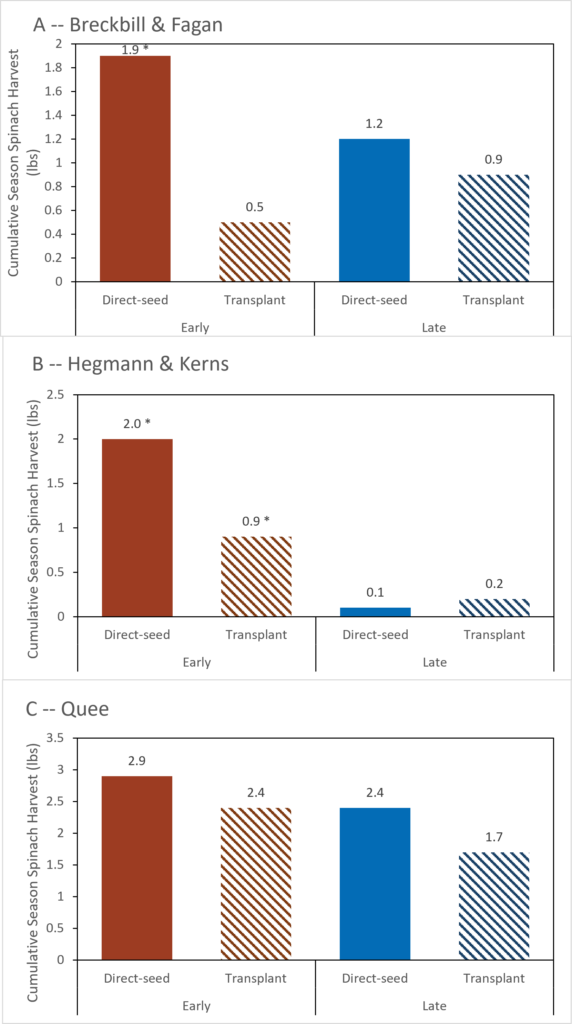
Figure 1. Average spinach yields per plot for each treatment at Breckbill & Fagan’s, Hegmann & Kern’s, and Quee’s. Note that Breckbill & Fagan did not have an Early transplant treatment because their starts did not germinate in the high August heat. Also, Hegmann & Kerns got spring harvests from only 2 of 4 replicates of their Early transplant and Late direct-seeded treatments due to poor germination and growth. *Indicates treatment(s) that yielded significantly higher than unstarred treatments at that location.
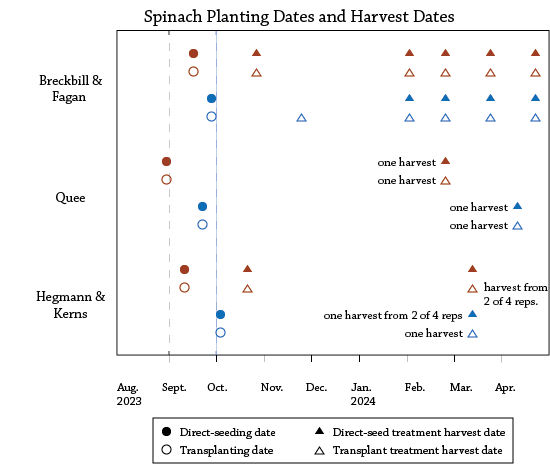
Figure 2. Spinach planting dates and harvest dates for each treatment at Breckbill & Fagan’s, Hegmann & Kern’s, and Quee’s. Note that not all replicates were harvested at each harvest date, but all replicates from all three trials were harvested on at least one date.
Weather considerations
Fall 2023 through spring 2024 brought some unusually warm weather conditions (Figure A2) and Quee shared it is “hard to know how much effect the warm weather had on the results of this trial.” The weather brought challenges with getting the spinach crop established; Breckbill & Fagan were unable to establish an Early transplant treatment because they seeded starts that largely did not germinate due to the heat. Other cooperators experienced more pleasant side effects of heat through the winter. Quee did not ever cover his spinach; by the time temperatures were cold enough in January, there was a thick blanket of snow covering his plants. Similarly, while Hegmann & Kerns covered the high tunnel spinach established for this trial with Remay for the winter, a neighboring high tunnel spinach row that was not part of the trial went uncovered and “yielded even higher quality spring spinach in terms of the leaf thickness and sweetness.”
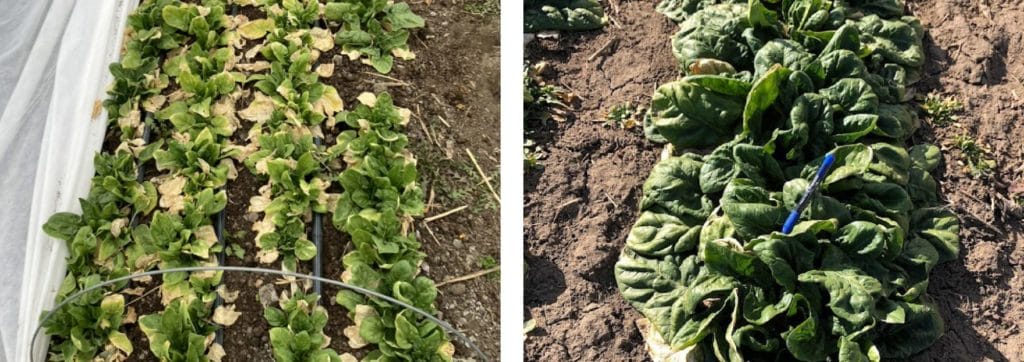
(Left) Overwintered spinach that was under row cover from November 2023 through February 2024 at Hegmann & Kern’s. Photo taken late February 2024. (Right) A large head of overwintered spinach that was unprotected in the field over the winter at Quee’s. Photo taken mid-April 2024.
Conclusions and Next Steps
These trials generally show that planting spinach for overwintering in early-to-mid September results in higher yields than planting later in the month and produces both a fall and spring crop in many cases. While direct-seeding does not result in definitively better yields, yields of direct-seeded spinach trended higher and direct-seeding requires less preparation and planting time than transplanting. This trial had warmer growing conditions than many cooperators were used to, which resulted in a very early spinach crop and less work covering plants to protect them from extreme cold. Hegmann & Kerns conclude that “Paying very close attention to our overwintering spinach led to a better crop and hopefully better crops in the future because of what we learned. We think we have discovered increased value and interest in very early spring spinach production.”
Appendix – Trial Design and Weather Conditions

Figure A2. Mean monthly temperature and precipitation during the study period and the 10-year historic monthly averages at each trial location [4, 5]. The data was obtained from the National Aeronautics and Space Administration (NASA) Langley Research Center (LaRC) Prediction of Worldwide Energy Resource (POWER) Project funded through the NASA Earth Science/Applied Science Program. Click to enlarge.
Funding Acknowledgement
This publication or project was supported by the U.S. Department of Agriculture’s (USDA) Agricultural Marketing Service through grant 23SCBPIA1187. Its contents are solely the responsibility of the authors and do not necessarily represent the official views of the USDA.
References
[1] H. Nelson, E. Fagan, H. Breckbill, and J. Yagla, “Effect of Seeding Date on Harvvest Window and Yield of Overwintered Spinach,” Practical Farmers of Iowa, 2022. [Online]. Available: https://practicalfarmers.org/research/effect-of-seeding-date-on-harvest-window-and-yield-of-overwintered-spinach/
[2] H. Breckbill, E. Fagan, J. Yagla, H. Nelson, and S. Gailans, “Overwintered Salad Greens Variety Trial,” Practical Farmers of Iowa, 2022. [Online]. Available: https://practicalfarmers.org/research/overwintered-salad-greens-variety-trial/
[3] E. Link, E. Fagan, and H. Breckbill, “Overwintering Greens: Species and Seeding Dates,” Practical Farmers of Iowa, 2023. [Online]. Available: https://practicalfarmers.org/research/overwintering-greens-species-and-seeding-dates/
[4] A. H. Sparks, “nasapower: A NASA POWER Global Meteorology, Surface Solar Energy and Climatology Data Client for R,” J. Open Source Softw., vol. 3, no. 30, p. 1035, Oct. 2018, doi: 10.21105/joss.01035.
[5] A. Sparks, “_nasapower: NASA-POWER Data from R_.” 2024. [Online]. Available: https://CRAN.R-project.org/package=nasapower

